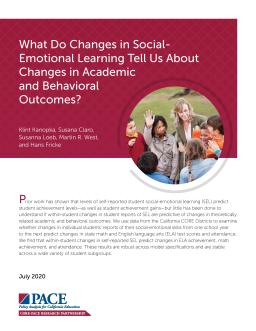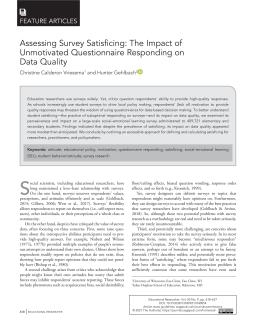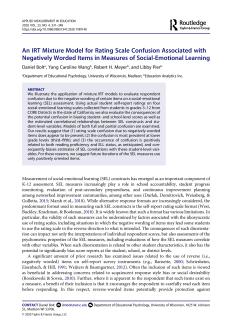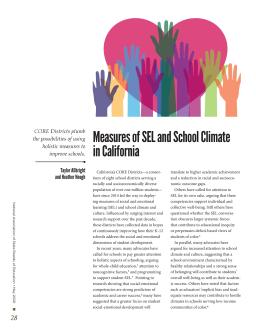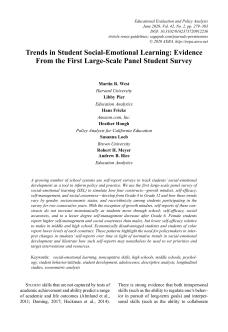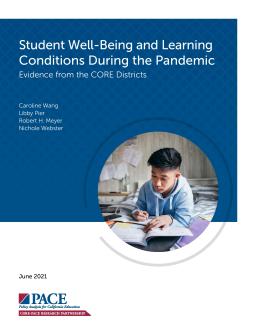Published
Summary
This study used data from California CORE Districts to explore whether changes in students' self-reported social-emotional learning (SEL) predicted changes in academic outcomes and attendance. The findings revealed that within-student changes in SEL were positively associated with improvements in English language arts (ELA) and math achievement, as well as attendance, and were consistent across various student subgroups.
The Impact of Unmotivated Questionnaire Responding on Data Quality
Published
Summary
This article explores the issue of satisficing, which is suboptimal responding on surveys, in the context of a large-scale social-emotional learning survey administered to over 400,000 elementary and secondary students. Despite concerns about its impact on data quality, the study found that satisficing had a more modest effect than expected. The article offers an approach for defining and calculating satisficing for researchers, practitioners, and policymakers to improve the quality of survey data.
… through the Policy Analysis for California Education’s CORE-PACE Research Partnership. We analyzed student responses to a … confirmatory study included students from a subset of the CORE school districts (see the full list here: …
Published
Summary
This article assesses confusion due to negative wording on social-emotional learning (SEL) assessments using mixture IRT models. Results based on student self-reports show confusion biasing scores, especially in Grades 3-5, and correlational relationships between SEL constructs and reading proficiency and ELL status. Using positively oriented items in future SEL measures is recommended to address these issues.
… scales collected from students in Grades 3–12 from CORE Districts in the state of California, it also evaluates … scales collected from students in grades 3–12 from CORE Districts in the state of California, we also evaluate … CORE districts: An IRT modeling approach. CORE-PACE research partnership working paper, Madison, WI. …
Published
Summary
California's CORE districts have been collecting data since 2014 on social and emotional learning (SEL) and school climate and culture to improve K-12 schools' holistic approach to student development. Advocates argue that a focus on SEL and school culture will lead to higher academic achievement and better well-being for students. The CORE districts developed survey instruments for SEL competencies and school climate perceptions involving students, staff, and parents. Many states and districts have adopted SEL-specific curricula and disciplinary reforms.
… Taylor N. Allbright Heather J. Hough California’s CORE districts —a consortium of eight school districts … SEL, schools’ climate and culture, or both. California’s CORE Districts first developed SEL and school climate … 12The full set of research from the CORE-PACE Partnership can be found on the PACE website: …
Evidence From the First Large-Scale Panel Student Survey
Published
Summary
Self-report surveys are used to track students’ social-emotional development. This large-scale panel survey reveals that self-efficacy, social awareness, and self-management decrease after Grade 6, except for growth mindset. Female students report higher self-management and social awareness but lower self-efficacy than males in middle and high school. Students of color and economically disadvantaged students report lower levels of each construct. Policymakers should consider these trends and use self-reports to target interventions and resources.
… whole student.”1 At the forefront of this trend are the CORE Districts, a network of large urban districts in … then-mandated under the No Child Left Behind Act.2 The CORE Districts used this flexibility to develop a measurement … This article was produced as part of the CORE-PACE Research Partnership, which is focused on producing …
Evidence from the CORE Districts
Published
Summary
The CORE Districts in California conducted a survey to measure K-12 students’ social-emotional well-being during the pandemic. Results indicate that students’ personal and interpersonal well-being rated lower than their learning environments. Interpersonal well-being was most correlated with academic achievement. Home/online learning environment improved, but Grades 5-12 students reported not liking school as much in winter 2020-21. Stakeholders should focus on meeting the pressing needs of each group of students.
… Learning Conditions During the Pandemic Evidence from the CORE Districts Caroline Wang Libby Pier Robert H. Meyer … their students’ social-emotional well-being, the CORE Districts in California developed survey instruments to … This paper was produced as part of the CORE-PACE Research Partnership, which is focused on producing …
